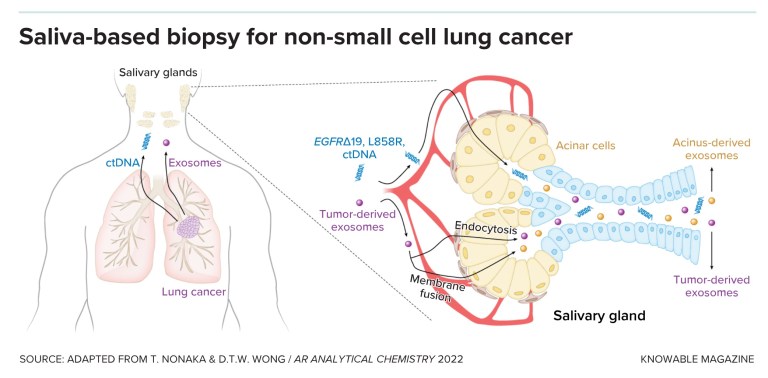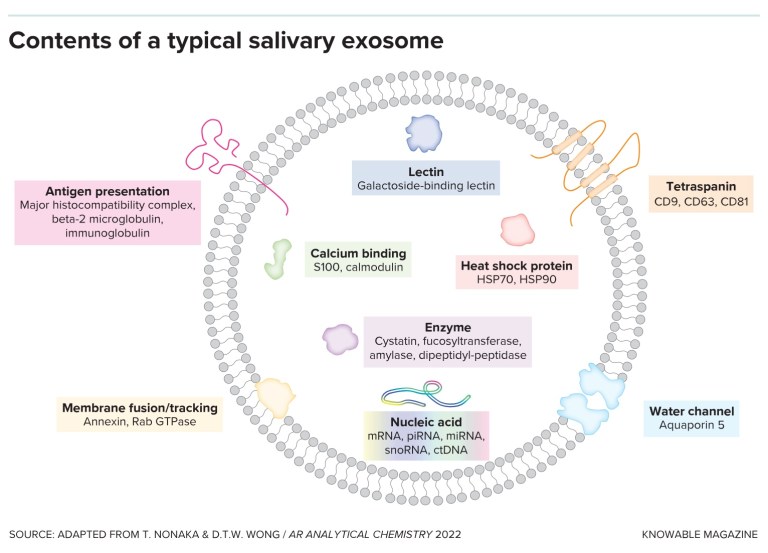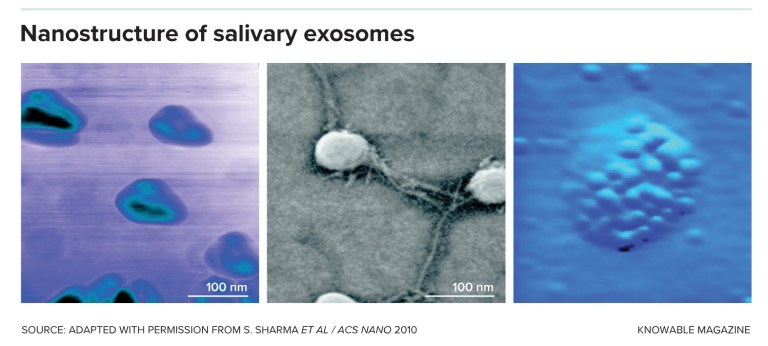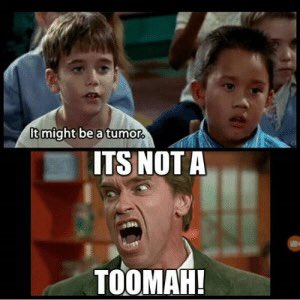
Posted on 03/31/2023 6:02:04 AM PDT by Red Badger
In the late 1950s, dentist and US Navy Capt. Kirk C. Hoerman, then a young man in his 30s, attempted to answer a bold question: Might the saliva of prostate cancer patients have different characteristics from that of healthy people? Could it contain traces of a disease that’s so far away from the mouth?
Without wasting more of their own saliva on elaborate discussion, Hoerman and his colleagues from the department of dental research at the Naval Training Center in Great Lakes, Illinois, got down to work. They analyzed samples from more than 200 patients and healthy controls, and found that the saliva of patients with untreated prostate cancer showed a significant increase in the levels of enzymes called acid phosphatases.
Writing in 1959 in the journal Cancer, the researchers then made a prescient reflection: that it may be valuable to observe discrete biochemical changes in tissues distant from the site of tumor origin.
More than 60 years later, the idea that saliva analysis can be used to detect different types of cancer is gaining traction in the scientific community. In the specialized literature, papers containing the keywords “diagnosis,” “cancer” and “saliva” grew more than tenfold over the past two decades, from 26 in 2001 to 117 in 2011, 183 in 2016 and 319 in 2021, according to the PubMed database, a search engine for biomedical research articles.
The appeal of this approach is obvious. Although cancer can be diagnosed through tissue biopsy, that requires trained physicians wielding long needles, scalpels, endoscopes or other tools to pry into the body to take samples. Liquid biopsy, which looks for traces of tumor components in fluids such as blood, urine, cerebrospinal fluid, semen or saliva, is a less invasive alternative. Of these, the simplest sample to collect is undoubtedly saliva.
The approach has already paid off: In 2021, the US Food and Drug Administration gave an innovative device designation to a saliva-based oral and throat cancerprediagnostic tool developed by the US company Viome. (Such designations are granted to novel medical devices that have the potential to provide more effective treatment or diagnosis of life-threatening diseases.) Based on artificial intelligence and machine learning, the tool analyzes a saliva sample for the activity of genes (in particular, messenger RNA) belonging to the bacterial community housed in the mouth. For unknown reasons, this community is modified when a tumor develops on the lips, tongue, throat or surrounding areas.
“For decades, saliva was considered a stepchild of blood,” says chemist Chamindie Punyadeera, who spent a decade working on Viome’s saliva diagnostic test. Now at Griffith University in Australia, she is lead author of a 2021 study describing the test’s development in NPJ Genomic Medicine. But that view of saliva as an afterthought could begin to change in the coming years as techniques to analyze it advance and a better understanding develops of what information it can hold. “Because saliva can be collected noninvasively, an empowered patient could take multiple samples and become a steward of his or her own diagnostic tests,” Punyadeera predicts.
The treasure contained in saliva
Every day, the salivary glands of an average adult produce between 500 and 1,500 milliliters of saliva to aid digestion and preserve oral health. In addition to enzymes, hormones, antibodies, inflammatory mediators, food debris and microorganisms, saliva has been found to contain traces of DNA and RNA or proteins from tumors.
“The goal of saliva diagnostics is to develop rapid, noninvasive detection of oral and systemic diseases,” write dental scientists Taichiro Nonaka of Louisiana State University and David T.W. Wong of the University of California, Los Angeles, in an article on saliva diagnostics published in the 2022 Annual Review of Analytical Chemistry. The field is developing rapidly due to the progress of “omics sciences” that analyze large collections of molecules involved in the functioning of an organism — such as genomics (genomes), proteomics (proteins) or metabolomics (metabolites) — as well as methods for analyzing large quantities of data. For example, the proteome of saliva — an exhaustive catalog of the proteins present in this fluid — is already available, and it is known that between 20 percent and 30 percent of the saliva proteome overlaps with that of blood.
But “the study of diagnostics through saliva is a relatively new field,” says Nonaka. It wasn’t until the last decade, he says, that it became known that salivary glands — parotid, submandibular, and sublingual, as well as other minor glands, in close proximity to blood vessels — transfer molecular information.
Today, in saliva — and also in blood — scientists are beginning to look for and find circulating tumor DNA (ctDNA), which is DNA that is shed from cancer cells when a tumor is present in the body. Multiple studies have identified biomarkers — such as proteins that are produced in higher quantities in cancer cells or genetic changes that occur in tumor cells — that could be used to detect tumors of the head and neck, breast, esophagus, lung, pancreas and ovary, as well as to monitor the patient’s response to therapies.

Scientists have found that saliva may contain biochemical signals (biomarkers) that provide an alert that a person has non-small cell lung cancer, the most common type of lung cancer. These signals are circulating tumor DNA (ctDNA) and tumor-derived exosomes that enter the circulation and reach the salivary glands. Both are taken up by secretory (acinar) cells of the salivary glands and are included in the saliva the glands produce. The presence of certain ctDNA mutations, combined with information provided by the exosomes, allow early detection and offer insight into the treatment of this type of cancer.
***************************************************************************************
Scientists have found that saliva may contain biochemical signals (biomarkers) that provide an alert that a person has non-small cell lung cancer, the most common type of lung cancer. These signals are circulating tumor DNA (ctDNA) and tumor-derived exosomes that enter the circulation and reach the salivary glands. Both are taken up by secretory (acinar) cells of the salivary glands and are included in the saliva the glands produce. The presence of certain ctDNA mutations, combined with information provided by the exosomes, allow early detection and offer insight into the treatment of this type of cancer. For example, in 2015 Chinese researchers published that the identification of two fragments of an RNA strand (microRNA) in saliva allowed the detection of malignant pancreatic cancer in 7 out of 10 patients with the disease. A more recent review of 14 studies involving more than 8,000 participants estimated that breast cancer patients were 2.58 times more likely to have certain saliva-detectable biomarkers — although 39 percent of the negative test results were in patients who actually had breast cancer. The research in the field is promising, but will require further prospective studies to determine its clinical applicability, Nonaka says.
“A great advantage of liquid biopsies is that they can sweep for up to 50 types of cancers in early stages at once, when they can be surgically treated or are candidates for short, targeted treatments,” says biologist Marina Simián, a researcher at Argentina’s National Scientific and Technical Research Council at the Nanosystems Institute of the National University of San Martín, in Buenos Aires. Simián is also cofounder of the company Oncoliq, which aims for the early detection of breast, prostate and other tumors from a blood sample.
“With today’s tools, very few organs are screened for cancer,” says Simián. Common screens include ones for prostate, breast, cervix, colon after the age of 50, and the lungs for those who have smoked heavily. And in the world, she says, only half of these people undergo these tests, and in many countries, not even 10 percent. The hope is to add many more tests that can be done on a single blood or saliva sample.
It is possible that in the future, testing of both blood and saliva will be the norm. Although there is still a long way to go, Nonaka believes that, except for oral cancers, saliva testing should most likely be supplemented with liquid biopsies in blood or urine, plus other parameters to increase sensitivity and practical utility.
In pursuit of exosomes
One particularly promising type of component to look for in saliva is the exosome. Exosomes are tiny lipid-wrapped vesicles that are present in almost all types of body fluids. They are transporters or messengers that travel from one cell to another — even to those in very distant organs. They carry a cargo of genetic material and proteins, which is taken up by a recipient cell in an organ and plays important roles in cell-to-cell signaling. But exosomes also have an important role in cancer. “They are key players,” says Punyadeera. Released by cancer cells, they pass into the blood and from there, can reach the salivary glands. The exosomes are thus dumped into the saliva, from which they can be collected.
Exosomes in saliva contain diverse cargoes. Shown are a variety of nucleic acids — messenger RNA (mRNA), microRNA (miRNA), piwi-interacting RNA (piRNA), small nucleolar RNA (snoRNA) — as well as classes of proteins that serve different functions. They include, among others, enzymes that catalyze biochemical reactions, proteins involved in the immune system, ones that regulate water transport across membranes and ones that modulate calcium activity. The exosome’s cargo may also include “messages” from nearby or remote tumor cells, known as ctDNA or circulating tumor DNA.

Exosomes in saliva contain diverse cargoes. Shown are a variety of nucleic acids — messenger RNA (mRNA), microRNA (miRNA), piwi-interacting RNA (piRNA), small nucleolar RNA (snoRNA) — as well as classes of proteins that serve different functions. They include, among others, enzymes that catalyze biochemical reactions, proteins involved in the immune system, ones that regulate water transport across membranes and ones that modulate calcium activity. The exosome’s cargo may also include “messages” from nearby or remote tumor cells, known as ctDNA or circulating tumor DNA.
*****************************************************************************************************
Exosomes from tumor cells have a specific composition and are suspected of contributing to the spread of cancer to other organs or tissues. But from a diagnostic perspective, one of their main advantages is that they package and protect the cargo — in other words, they do not mix with the other components of saliva. In this way, they provide “more stable and accurate clinically relevant information for disease detection,” Nonaka explains.
For example, for squamous cell esophageal cancer, scientists have found two signatures or signals in salivary exosomes that allow detection of this disease with a sensitivity and specificity of more than 90 percent, in addition to providing guidance on prognosis and treatment, as reported in January 2022 in Molecular Cancer.
Factors such as the concentration or appearance of exosomes under the microscope can also be revealing. Patients with oral cancer, for example, have exosomes with different shapes and sizes than those found in healthy individuals.
However, the techniques available so far to isolate and study the exosome content of saliva are expensive and laborious. In response to this challenge, a new method known as electric field-induced release and measurement, or EFIRM, has emerged; it integrates electrochemical sensors and magnetic fields to elegantly capture minute amounts of circulating tumor DNA and other molecules — biomarkers — that indicate the presence of cancer. This technique has already shown encouraging results in the early detection of non-small cell lung cancer and could also be used to assess response to treatment.
Although often described as “little bubbles,” exosomes are not necessarily perfect, solitary spheres. In the first image, taken with an atomic force microscope, lobes or waves are observed. In the second, taken with a field emission scanning electron microscope, connections between exosomes are visualized. The third, an electron microscopy image, shows the external “roughness” of the exosome due to the presence of proteins on its surface.

Although often described as “little bubbles,” exosomes are not necessarily perfect, solitary spheres. In the first image, taken with an atomic force microscope, lobes or waves are observed. In the second, taken with a field emission scanning electron microscope, connections between exosomes are visualized. The third, an electron microscopy image, shows the external “roughness” of the exosome due to the presence of proteins on its surface.
*****************************************************************************************************
The US company Liquid Diagnostic LLC, in which Wong has a stake, already offers this technology, having christened it Amperial and promising “the highest specificity and sensitivity for early stage cancers” and at “much lower cost.” Those most enthusiastic about the technology propose a world where a routine visit to the dentist saves lives and it is not necessary to draw blood to check if someone is ill. But experts agree that, for that dream to become a reality on a large scale, more studies are still needed.
“To achieve the translation of salivary biomarkers to the clinic, it is necessary, on the one hand, to develop standardized protocols and, on the other, to carry out large multicenter studies in which the influence of different confounding variables such as age, sex or lifestyle is analyzed,” says dental scientist Óscar Rapado González, of the Health Research Institute of Santiago de Compostela, in Spain, where he is investigating the use of saliva samples for the detection of head and neck cancers, as well as colorectal tumors.
The identification in saliva or other fluids of molecules directly or indirectly related to tumors has potential apart from early detection, says Rapado González. It might make it possible to assess individual risk of developing cancer, predict how a tumor will evolve or monitor the therapeutic response in a noninvasive way, allowing the development of personalized medicine.
“Undoubtedly,” Rapado González says, “more research in this field will drive progress toward the applicability of saliva in precision oncology in the coming years.”
Article translated by Debbie Ponchner
This article originally appeared in Knowable Magazine, a nonprofit publication dedicated to making scientific knowledge accessible to all. Sign up for Knowable Magazine’s newsletter.
I think saliva causes cancer.
Swallowing small bits of it for decades apparently does..................
I can see this as possible. I had my DNA done at MyHeritage a few years ago to see if my dad’s genealogy searches were right. They were.
A family member that I found though the DNA check pointed me to a place called Promethease. You upload your raw data, they analyze it, and tell you what diseases and conditions you are susceptible to from your DNA. Some of the results won’t apply to you unless you have Asian, etc. in your ancestry so you have to weed through it.
Mine was extremely accurate. It said I had a chance of genetic high cholesterol (I do). It also said I was at risk of being an alcoholic. I don’t drink but I have one brother that is an alcoholic. It didn’t find any cancer risks unless I had some Asian DNA (I don’t).
The point of it isn’t to say you WILL have issues but that you MIGHT have issues with some behaviors. It’s like an early warning system.
If they can do that, why can’t they find cancer through DNA?
DNA doesn’t take into consideration environmental factors a person may be exposed to, and individual destructive behaviors, like drugs and alcohol.
It’s like a stick of dynamite without a fuse. It might never explode until someone adds the fuse and then something lights it later..................
It’s kind of interesting that we have all of the top medical technology and diagnostic$ now to “ fight cancer” - and cancer rate$ are higher than they’ve ever been.
Though it couldn’t be the ultimate goal of “saliva testing” - it just happens that it’s another pretense it will be an easy way to gather even more individual human DNA.
For that massive DNA database that the WHO - or some other global entity keeps because of ......Covid .....or something.
That is correct. My report said that if I do this, that might happen. In other words, light the fuse and maybe it will and maybe it won’t. I avoid alcohol and don’t panic over my cholesterol because of it. Even my doctor wanted a copy of the report. There were some meds in the report that I might have trouble with, so she wanted to know about them.
They do the same for dogs. Some dogs have genes that trigger reactions to some drugs and meds.
I don’t drink.
My dog doesn’t drink, either.
I used to have a dog that did.................
ROTFL, I had a horse that drank beer, even if he had to steal it from somebody. I couldn’t even ride him on the road. He picked up every beer carton he found to shake it and see if anything fell out.
This dog, a female chow mix, I had would sneak up and steal anybody’s beer they left alone on a table or anywhere if she smelled it.....................
We used to take the horses to the mountains to camp and trail ride. There was always a group of us. This horse actually untied himself once in camp and took a man’s beer away from him. He grabbed it out of his hand, turned it up, and finished it off. Before I could grab the horse, he dropped the empty can, walked over to a kid, and grabbed his bag of chips.
Somebody really taught this horse some bad habits before I got him.
Good thing he didn’t smoke........................

I guess whoever taught him his vises didn’t smoke. 😁
Obesity in my opinion can increase susceptibility to cancer.
Yes, several types...............
Disclaimer: Opinions posted on Free Republic are those of the individual posters and do not necessarily represent the opinion of Free Republic or its management. All materials posted herein are protected by copyright law and the exemption for fair use of copyrighted works.